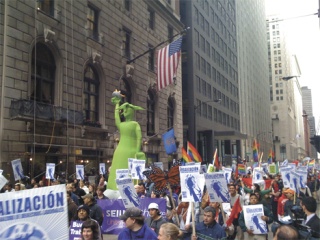Backbone Campaign’s “Procession for the Future” tour concluded last week, when a biodiesel truck stuffed with 25 parade floats rolled back onto Vashon after traveling more than 11,000 miles around the country.
Along the way, the truck and a small Backbone crew stopped in 16 cities, gave life to eight parades and taught more than 800 people to communicate their ideological messages in a way they hope is engaging.
The tour, though partially funded by a foundation grant, also drained the reserves of the left-leaning nonprofit, which has gained notoriety over the years for its use of huge puppets and images to convey its political ideas. From Snowflake the Polar Bear, who reminds spectators about global warming, to Juan and Al, two enormous fair-trade farmers, Backbone Campaign parade floats are emotive for many and capture attention much better than an e-mail or flier, organizers say.
While Backbone received a $50,000 grant from the Nathan Cummings Foundation for the ambitious tour, it spent $60,000 to carry it out. The group now seeks a fresh flow of funding to help it in its next effort — continuing the fight against Glacier Northwest’s expansion on Maury Island.
The group is planning an “activist training camp” in July, aimed at helping people protest the mining company’s pier construction. But the group is out of cash, said its executive director, Bill Moyer.
Backbone is holding a phone-a-thon and e-mail appeal this month, he said, and an auction and music gala May 30 that he hopes will enable the group to put on its weeklong camp, when the group intends to educate at least 100 activists.
“We’re hoping that’ll get us through the summer,” Moyer said of this spring’s fundraising efforts.
Since 2006, Backbone Campaign was supported by an “angel” who gave large donations to the organization each year. But this year, as planned, the individual stopped financing the nonprofit, and it’s up to Backbone to take off on its own. While it is seeking grants, the five-year-old organization is counting on individual donors to help it stay afloat, Moyer said.
Islanders provide 65 percent of its financial support, he added.
Even before the small nonprofit concluded its 11-week tour in Chicago on May Day, Moyer was looking ahead to this summer’s intensely local action.
That day, Backbone Campaign floats joined in a demonstration march championing workers’ rights, with Lady Liberty, Juan and Al and even the world held above the 2,000 marchers.
From Feb. 21 to May 4, a cadre of four Backbone employees shared these images and other tactics of communication with small groups as far away as Gainesville, Fla., and Boston. Some groups had a specific topic they were passionate about, such as immigration or health care, while others, like Backbone, are built around politically progressive values.
Moyer and a trio of truck-driving activists taught people how to make their own silk screens, helped them string up banners over freeways and encouraged them to convey their messages in a way others “cannot ignore,” he said.
They relied on their national “network of friends and allies and collaborators” to find them housing, staying in a hotel only once.
“Sometimes, it’s college students, and we’re sleeping on the couch, and other times, it’s a retired person who loves our work and is happy to have us stay in their extra room,” Moyer said of the 11-week tour. “They’re all people who were excited to have a truckload of puppets parked outside their door, and to spend a few days with people who are nutty enough to go on the road for weeks to do parades.”
It wasn’t all puppets and parades, however. The Backbone crew trained activists “to use arts for social change,” said Julian Park, a 2007 Vashon High School graduate who now attends Brown University in Providence, R.I.
He and other members of Students for a Democratic Society at Brown learned from the Backbone staff how to make a human blockade using their bodies and PVC tubes, he said. They used their training to create a blockade in Washington D.C. later that month.
“All of us who were involved in the blockade found the training to be incredibly helpful,” he said. “It helped us feel more comfortable with what we were doing.”
Vashon, too, could have human blockades in its future, when some Islanders take on Glacier. Earlier this year, activists created a similar blockade to slow the construction workflow of Glacier’s 305-foot pier.
“I’m excited to bring our attention back to Vashon,” Moyer said.
Still, he admitted it’s difficult to run a political nonprofit.
Every year, “it’s this crazy seasonal dance of trying to raise money,” Moyer said.
“If we weren’t in the middle of the meltdown of the stock market, it might be that we’d be able to invest more of our hope in foundational support and grants,” he said. “But the reality is, those foundations are cutting back, … so we have to go back to our community supporters for the majority of our expenses.”



